Nature Now! Ghost Hunting
For immediate release ‐ June 02, 2021
Nature Now
Contact: Micah Beasley, 919.707.9970. Images available upon request
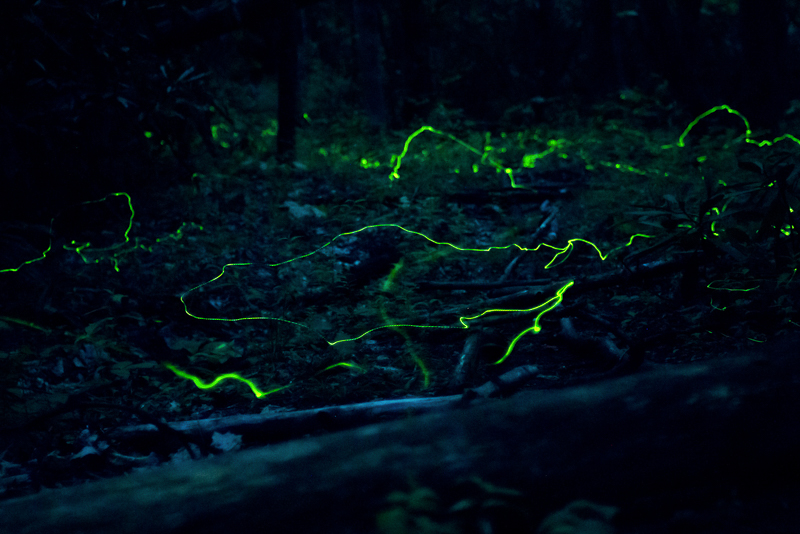 Blue Ghost Fireflies dance above the ground in a moist area near a stream in Pisgah National Forest in late May. Photo: Jordan Mitchell.
Blue Ghost Fireflies dance above the ground in a moist area near a stream in Pisgah National Forest in late May. Photo: Jordan Mitchell.
By Jerry Reynolds, Head of Outreach
Earlier this year Dr. Clyde Sorenson, a professor at North Carolina State University, contacted me to help recruit people for a ghost hunt. (Who you gonna call? OK, not that kind of ghost hunt!) Dr. Sorenson, an entomologist, was in search of the Blue Ghost Firefly. The Blue Ghost Firefly, Phausis reticulata, is well known in the mountains for putting on a light show each year. Along with the Smokies Synchronous Firefly, Photinus carolinus, it draws so many spectators that some places have a lottery system to keep the crowds manageable.
The firefly that Dr. Sorenson is looking for may be a new species in the Piedmont of North Carolina related to the Blue Ghost Firefly. He knew of only one population of this Piedmont Blue Ghost on private land in Chatham County. Thinking they should occur elsewhere, he wanted help looking for them. Dr. Sorenson put out a call to “Help Us Find the Piedmont Ghosts!” on social media.
Who doesn’t love a ghost hunt, particularly if it involves fireflies?
First, let’s set the record straight – fireflies are not flies! They are beetles which produce light in order to find appropriate mates in the darkness, ensuring future generations of fireflies. There are about 35 species of fireflies in NC. They vary morphologically, but more importantly for insects that mate in the dark, they vary aspects of their flashing behavior. Flash duration, frequency, brightness, location and timing are all specific to a species. This “light code” is how they find the right mate for reproduction.
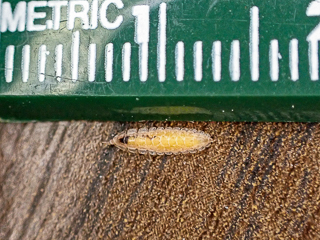
Female Piedmont Blue Ghost with ruler. Photo: Jerry Reynolds.
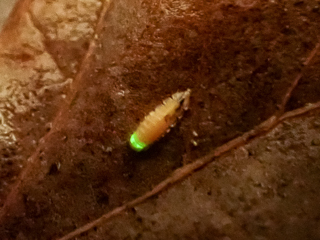
Female Piedmont Blue Ghost glowing. Photo: Jerry Reynolds.
The Blue Ghost Firefly is very small (about the size of a grain of rice) and produces a dim but continuous green light. The dim green light appears blue or blue green to most people in the darkness of the night. The dim lights must have appeared somewhat ethereal to first observers — ghostly apparitions in the darkness — leaving them thinking they were seeing things! Only the brave stuck around in the dark woods to discover the real source of the light.
Female Blue Ghost Fireflies are wingless and differ in appearance from the males: they have a ghostly transparent exoskeleton resembling the larval form of the firefly. Since females can’t fly, they crawl to the top of the leaf litter and turn on their light hoping to attract the attention of males flying low, searching for the female’s dim beacon. If all works out, enough of them will mate each year to continue the cycle of life. Males and females die a few weeks after mating. The female’s last act in life is to guard the 20 to 30 eggs that she laid.
Back to our ghost hunt! On May 1, Dr. Sorenson posted success on social media — four new sites in Wake and Chatham Counties! One of these sites was in Durant Park in North Raleigh, discovered by retired Museum educator John Connors. John was Raleigh City Parks’ Naturalist in the mid-80s, and led night hikes for 5th graders. After reading Dr. Sorenson’s original post, he remembered seeing tiny faint fireflies on those night hikes almost forty years ago. He was intrigued by them and even called them little phantom fireflies. But he never tried to identify them or bring them to anyone’s attention at the time. He and Dr. Sorenson met at Durant Park a few weeks ago and found that John’s phantom fireflies are still there!
A Ghost of a Chance
Wow, this was all great news! I commented on Dr. Sorenson’s post, asking if he thought they might occur in our part of Johnston County. (We live in neighboring subdivisions in Johnston County.) He quipped, “It’s worth looking!” Well, my “looking” was mostly scanning my backyard from the deck. Knowing how close Dr. Sorenson lived to me, I thought, if he hasn’t seen them at his house, it’s very unlikely I would have them at mine. I did see fireflies in the backyard, but only the brighter and more common species.
Another week passed and I was sitting in my recliner after supper scrolling social media posts when Dr. Sorenson posted “Any luck?”, referring to his, “It’s worth looking!” comment. I immediately responded, “You would know if I did!”, not wanting to admit that I hadn’t really looked very hard. I felt bad after sending that evasive reply. Yes, I looked into the yard occasionally, but hadn’t really looked seriously for them. I pried myself from the comfort of the recliner, grabbed a red flashlight (red light preserves night vision) and headed outside. I crossed the small stream behind my backyard and began making my way upslope in the woods. I wanted to make it to the top of the wooded slope to verify they weren’t there, just so I could return to the comfort of my recliner with a clear conscience.
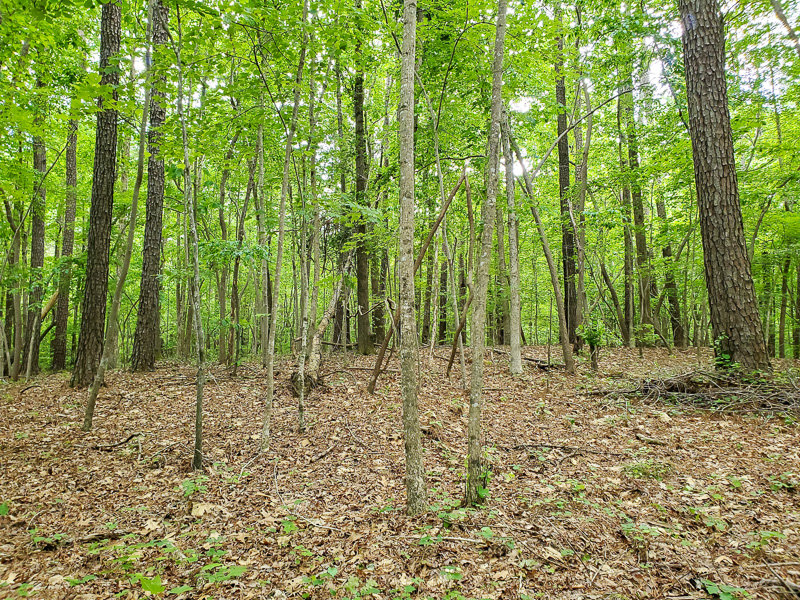 Piedmont Blue Ghost "Haunted Woods." in Johnston County, North Carolina. Photo: Jerry Reynolds.
Piedmont Blue Ghost "Haunted Woods." in Johnston County, North Carolina. Photo: Jerry Reynolds.
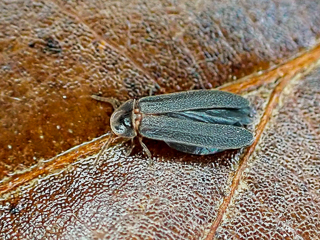
Male Piedmont Blue Ghost firefly. Photo: Jerry Reynolds.
I was almost to the top when I thought I saw something! I stopped in my tracks! Did I really see something or were my eyes or mind playing tricks on me? There it was again! A dim bluish light moving low just ahead of me! Really? Then I looked upslope a bit more—the wooded hilltop was dancing with about two dozen dim bluish lights wavering just above the ground — Blue Ghosts! I saw females in the leaf litter along with males flying overhead. Some males were getting caught in spider webs, so I grabbed one of those and carried it back home as proof that I really saw them.
I never expected to find them behind my house. I was eager to reach Dr. Sorenson, finally connecting with him by phone later that night with my positive report — the first for Johnston County. Dr. Sorenson had made numerous trips to other counties to search for the fireflies, but he had never looked for Blue Ghosts in his own backyard. He finally did after learning of my success and found them behind his house too!
Dr. Sorenson thinks this Piedmont Blue Ghost is a new species of Phausis and may be more common than originally thought. They have a short mating period and display such dim lights that the fireflies would only be noticeable in dark woods away from the glow of houses and streetlights. People who do see them may think they’re just another firefly, which they are. But one that is not well known to science, and that has been hiding nearby, dimly lit, but in plain sight.
If this Piedmont Blue Ghost behaves like the mountain form, then there may be another period of mating activity in June. You can join us in our Blue Ghost hunt by looking in some dark woods near you, generally beginning about 45-60 minutes after sunset. They will be active maybe for a couple of weeks and generally for only about 15–30 minutes each night. Please do join us on our ghost hunt!
If you think you have seen ghost fireflies, particularly in the Piedmont, please consider joining our Carolina Ghost Hunt to learn more about them and how you can help us!
More information about how to participate is available at this website: https://carolinaghosthunt.org/
For more information about our upcoming activities, seasonal news and ground-breaking research, follow @NaturalSciences on Instagram, Twitter and Facebook. Join the conversation with #visitNCMNS.

